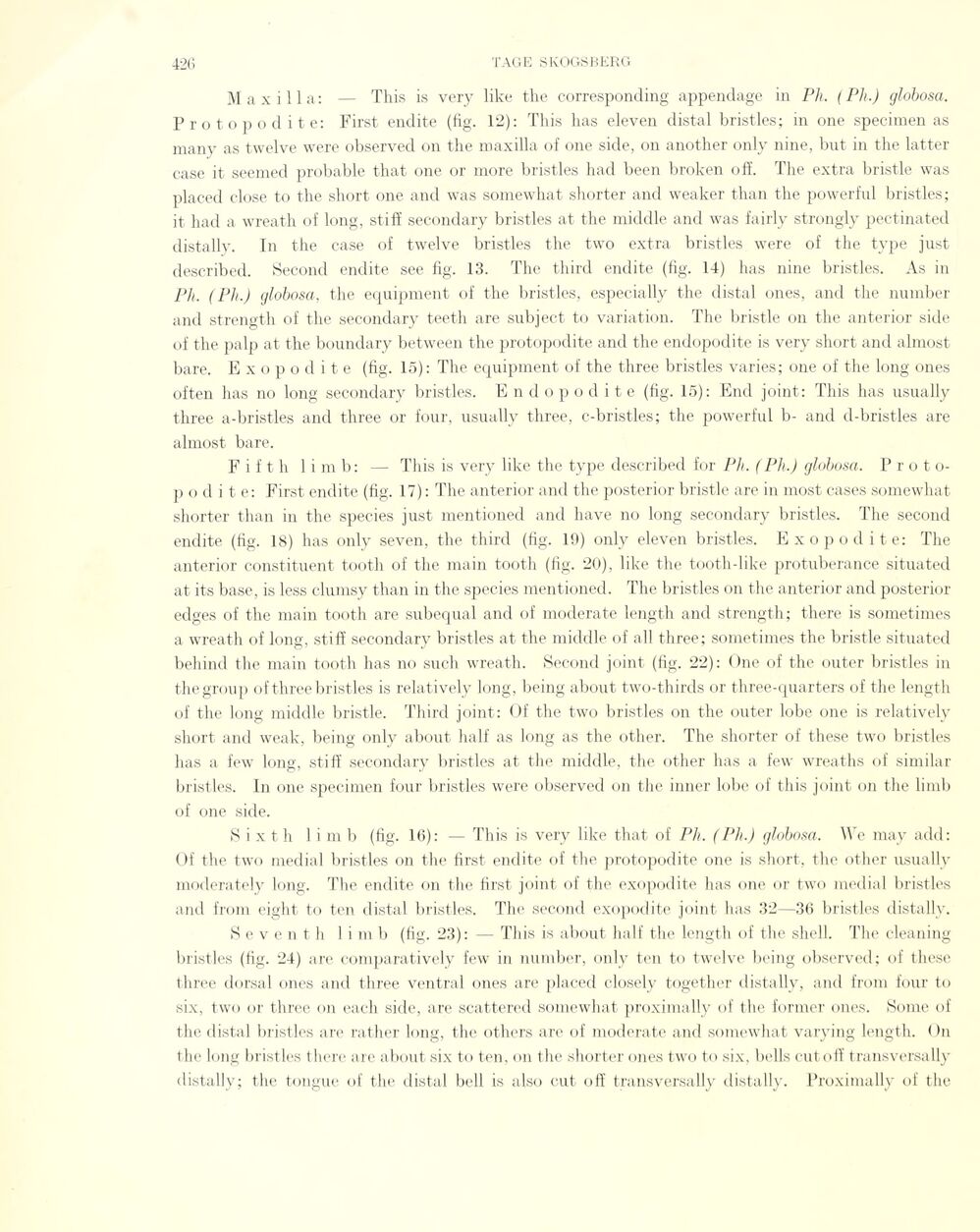
Full resolution (JPEG) - On this page / på denna sida - Sidor ...

<< prev. page << föreg. sida << >> nästa sida >> next page >>
Below is the raw OCR text
from the above scanned image.
Do you see an error? Proofread the page now!
Här nedan syns maskintolkade texten från faksimilbilden ovan.
Ser du något fel? Korrekturläs sidan nu!
This page has never been proofread. / Denna sida har aldrig korrekturlästs.
Maxilla: — This is very like the corresponding appendage in Ph. (Pli.) globosa.
Protopodite: First endite (fig. 12): This has eleven distal bristles; in one specimen as
many as twelve were observed on the maxilla of one side, on another only nine, but in the latter
case it seemed probable that one or more bristles had been broken ofE. The extra bristle was
placed close to the short one and was somewhat shorter and weaker than the powerful bristles;
it had a wreath of long, stiff secondary bristles at the middle and was fairly strongly pectinated
distally. In the case of twelve bristles the two extra bristles were of the type just
described. Second endite see fig. 13. The third endite (fig. 14) has nine bristles. As in
Ph. (Ph.) globosa, the equipment of the bristles, especially the distal ones, and the number
and strength of the secondary teeth are subject to variation. The bristle on the anterior side
of the palp at the boundary between the protopodite and the endopodite is very short and almost
bare. Exopodite (fig. 15): The equipment of the three bristles varies; one of the long ones
often has no long secondary bristles. Endopodite (fig. 15): End joint: This has usually
three a-bristles and three or four, usually three, c-bristles; the powerful b- and d-bristles are
almost bare.
F i f t h 1 i m b: — This is very like the type described for Ph. (Ph.) globosa. P r o t
o-p o d i te: First endite (fig. 17): The anterior and the posterior bristle are in most cases somewhat
shorter than in the species just mentioned and have no long secondary bristles. The second
endite (fig. 18) has only seven, the third (fig. 19) only eleven bristles. Exopodite: The
anterior constituent tooth of the main tooth (fig. 20), like the toothdike protubérance situated
at its base, is less clumsy than in the species mentioned. The bristles on the anterior and posterior
edges of the main tooth are subequal and of moderate length and strength; there is sometimes
a wreath of long, stiff secondary bristles at the middle of all three; sometimes the bristle situated
behind the main tooth has no such wreath. Second joint (fig. 22): One of the outer bristles in
thegroup of three bristles is relatively long, being about two-thirds or three-quarters of the length
of the long middle bristle. Third joint: Of the two bristles on the outer lobe one is relatively
short and weak, being only about half as long as the other. The shorter of these two bristles
has a few long, stiff secondary bristles at the middle, the other has a few wreaths of similar
bristles. In one specimen four bristles were observed on the inner lobe of this joint on the limb
of one side.
S i X t h 1 i m b (fig. 16): — This is very like that of Ph. (Ph.) globosa. Wo may add:
Of the two medial bristles on the first endite of the protopodite one is short, the other usually
moderately long. The. endite on the first joint of the exopodite has one or two medial bristles
and from eight to ten distal bristles. The second exopodite joint has 32—36 bristles distally.
S e v e n t h limb (fig. 23) : — This is about half the length of the shell. The cleaning
bristles (fig. 24) are comparatively few in number, only ten to twelve being observed; of these
three dorsal ones and three ventral ones are placed closely together distally, and from four to
six, two or three on each side, are scattered somewhat proximally of the former ones. Some of
the distal bristles are rather long, the others are of moderate and somewhat varying length. On
the long bristles there are about six to ten, on the shorter ones two to six, belis cutoff transversally
distally; the tongue of the distal bell is also cut off transversally distally. Proximally of the
<< prev. page << föreg. sida << >> nästa sida >> next page >>